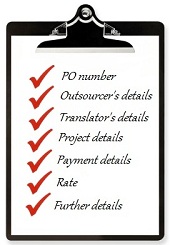What is a PO and why is it important in freelance translation? |
By Lucia Leszinsky |
Published
01/16/2013
|
Business Issues
|
Recommendation:    
|
|
Contact the author
|
|
Quicklink: http://hin.proz.com/doc/3716
|
|
|
|
|
On a recent ProZ.com survey on disputes between service providers and outsourcers, 59.6% of professional translators (most of them with at least 5 years of experience in the translation industry) stated that they do request a PO with relevant and complete project details as a measure to prevent disputes with clients.
What is a PO?
A project order (PO) --or purchase order-- is a commercial document issued by a buyer to a seller, indicating types, quantities, and agreed prices for products or services the seller will provide to the buyer. Sending a project order to a supplier constitutes a legal offer to buy products or services. Acceptance of a project order by a seller usually forms a contract between the buyer and seller, so no contract exists until the project order is accepted.*
Why are POs important in freelance translation?
Since issuing a PO constitutes a legal offer and accepting a PO constitutes an acceptance of such offer, including the conditions specified by the PO, project orders are in most cases the only proof of a commercial relationship between a buyer (translation outsourcer) and a seller (translator). Just as contracts, written POs provide translators and outsourcers with a formal document that outlines in detail what is expected from each of them, how and when, and anticipates to potential issues that may arise between both parties, providing specifications on how these will be solved. In sum. POs are a very useful tool to safeguard freelancers and outsourcer's resources.
Advantages
- POs allow freelance translators and outsourcers to discuss the conditions and terms of a project in advance.
- Freelance translators can use POs to claim payment of the services offered in case of non-payment issues.
- POs help outsourcers, specially translation agencies, to keep track of their orders and payments.
What information should a PO include?
Every translation project order should include at least the following information:

- Outsourcer's details: full (real or company) name, address, primary and secondary phone numbers, primary and secondary email addresses, tax/business registration number and (digital) signature.
- Project order number: this could be any number, depending on the number of orders an outsourcer has issued. If the outsourcer is a direct client (not a company ), the translator may need to create the PO for them. In this case, the number will depend on the number of orders created by the translator.
- Service provider's details: full (real or company) name, address, primary and secondary phone numbers, primary and secondary email addresses, and tax/business registration number.
- Project name / denomination: this may be the name of the file that includes the project or else any name the outsourcer has chosen for the project (eg. "ENG>FRE_contract_I").
- Project files: the name of the file(s) included in the project. This helps the translator to know exactly what files to expect and let the outosurcer know if any file is missing when s/he starts working on the project.
- Project languages: both source and target language(es) involved, including language variants.
- Project volume: the total amount of source characters / words / lines / pages / the project contains or the total amount of hours that will be devoted to the service.
- Project source format: the original source file format.
- Project delivery / target format: the file format expected to be delivered.
- Delivery deadline: date and time (including time zone) for project delivery.
- Software required (if any): any software needed for the performance of the task and required by the outsourcer (eg. CAT tool).
- Rate: it should be clarified whether the rate offered-accepted is per source or target character / word / line / page or if it is per hour.
- Rate total: the total amount to be paid to the translator based on volume and rate (rate X volume = rate total).
- Currency: the currency in which the rate is being set (Euro, USD, Pounds, etc.).
- Primary payment method: the payment method the outsourcer will use to transfer the money for the service to the service provider.
- Secondary payment method: an alternative payment method in case any issue arises with the use of the primary payment method.
- Payment deadline: the date and time limit for the service provider to receive the outsourcer's payment.
- Surcharges: a percentage or a value that will be added to the total amount (per day, for example) in case of late payment.
- Discounts: a percentage or value to be discounted from the total amount (this may be more common when large projects are involved).
- Invoicing instructions: any specific instructions regarding invoicing (name and email address of the person who will take care of issuing payment, for instance).
- Terms and conditions: any further terms and conditions in connection with the project and the business relationship (eg. non-disclosure agreement).
- Additional information/requirements: this section may include any type of information that may be useful or relevant to either the translator or the outsourcer, or to both (client's website URL , useful website URL(s), termbase or TM name, formatting guidelines, etc.).
Further tips
- Project orders may be accompanied by a separate, formal agreement stating that the acceptance of the PO from both parties represents a legal agreement.
- Project orders may be issued/requested as a separate file or as part of an email message (in the body of the email message).
- Always store a copy of POs you issue or receive in your computer for future reference.
.............................................
Thank you members of the ProZ.com Certified PRO Network for your feedback on this topic! |